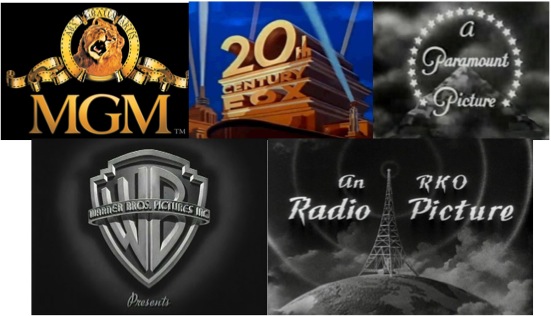Studio Systems
Between 1930 and 1960 there were 5 major film studios that were all known from their different styles
- MGM
- MGM was the biggest studio out of the 5 main studios in America
- It was ran by Louis B Mayer and Irving Thalberg
- It was famous for making films such as the Wizard of Oz (Fleming, 1939) and Gone with the Wind (Fleming, 1939)
- Paramount Pictures
- This studio was called the most European as it took directors from the UK and Germany
- There was more freedom in Paramount for directors to put their own stamp on the films being made
- Famous films made from this studio were Morocco (Von Sternberg, 1930) and Shanghai Express (Von Sternberg, 1932)
- Warner Brothers
- This studio was often called ‘The Studio of the Working Class’
- It was famous for making low-budget mellow-dramatic films
- Famous for Public Enemy (Wellman, 1931) and Footlight Parade (Berkeley and Bacon, 1933)
- 20th Century Fox
- The reputation of this studio grew from its chief director John Ford
- Well known for The Grapes of Wrath (Ford, 1940)
- RKO
- This studio was the home of musicals
- It was an experimental studio as it took a lot of chances
- Famous for King Kong (Cooper and Schoedsack, 1933) and Citizen Kane (Welles, 1941)
There were also 3 independent studios that were competing against the famous five to get their films created
- United Artists
- Part of the Society of Independent Motion Picture Producers in 1940s and 1950s
- One of its co-founders was Charlie Chaplin
- Made Moulin Rouge (Huston, 1952)
- Columbia Pictures
- Now the 5th largest film production studio
- Made a profit from their biggest star, Rita Hayworth, in 1940s
- Universal Pictures
- Was originally known for creating horror films like the Bride of Frankenstein (Whale, 1952)
Vertical Integration
This was used in the golden age of Hollywood to describe the ownership the studios had over the films being produced. The studio had control over the actors, the making of the film and the marketing and exhibiting of the film after it had been produced. For example, Humphrey Bogart, famous for Casablanca (Curtiz, 1942), could only be used in Warner Brother studios films as the studio had signed him to complete a certain number of films under the studio.
Through the Supreme Court in 1948, the studio system was challenged under the anti-trust laws, which sought to separate production from the distribution and exhibition. This court case ended these practices, thus ending the studio systems of the Classical Hollywood Era. Of course there are film studios now, but they have a lot less power over the film produced compared to the Classical Hollywood Era.
The Star System and Unbreakable Contracts
This was a way of studio systems to create and promote up and coming stars. They would sign the star to do a certain amount of movies with the studio, an example of this is Humphrey Bogart as explained above, and either release them or sign a new contract of another set of films with the studio. These contracts meant that whilst the star was making movies with Warner Brothers, for example, they could not make another film with MGM until their contract had finished. This was used by studios as people went to go see a film due to the actors who were in it and not to do with the genre.
Classical Hollywood Style
The style at the time was heavily influenced around the Renaissance era. It was distinguished at three different levels: devices, systems and the relations of the systems
- Devices
- The essential part of Classical Hollywood Style films is continuity editing. This includes the 180 degree rule and the 30 degree rule. The main focus of the editing was to show a story and not to take the effect of the story away from the viewer by doing jarring editing, like jump cuts.
- Systems
- Narrative Logic
- The narrative of this style was always showed the progression through a psychological motive. There is often a primary narrative, normally romance, intertwined with a secondary narrative, often business or crime. There is a classic beginning, middle and an end, with the end showing how the problem has resolved.
- Cinematic Time
- Time is linear during Classical Hollywood cinema. The only manipulation of time is through flashbacks, only used if necessary.
- Cinematic Space
- This is where the biggest rule of Classical Hollywood Style takes place: the viewer must believe that the scene exists outside the shot of the cinematic frame to maintain the picture’s realism. The majority of the shots in Classical Hollywood cinema focus on gestures and facial expressions. Important people in the frame are generally placed in the centre and are rarely out of focus.
- Narrative Logic
- Relations of Systems
- Cinematic space and time are in a lower position than the narrative, showing the narrative is the most important aspect of the Classical Hollywood Style.
Warner Bros House Style
Warner Bros brought realism to the big screen and often mimicked the sound of the times. They focused on the Depression era of America and focused on appealing to ordinary workers. The house style of Warner Bros focused on: urban settings, snappy dialogue and a brisk pace, with scripts and performances that never strayed into sentimentality. At the time many studios chose their main actors and actresses due to their looks. Warner Bros main cast were chosen due to their large personalities, which was often portrayed on-screen. Warner Bros films, therefore, always felt more authentic which was what captured a lot of people to watch Warner Bros films. Trademark films for Warner Bros were gangster films, action-adventure films and hard-hitting films.

